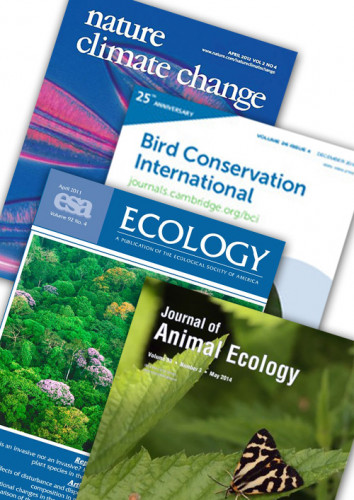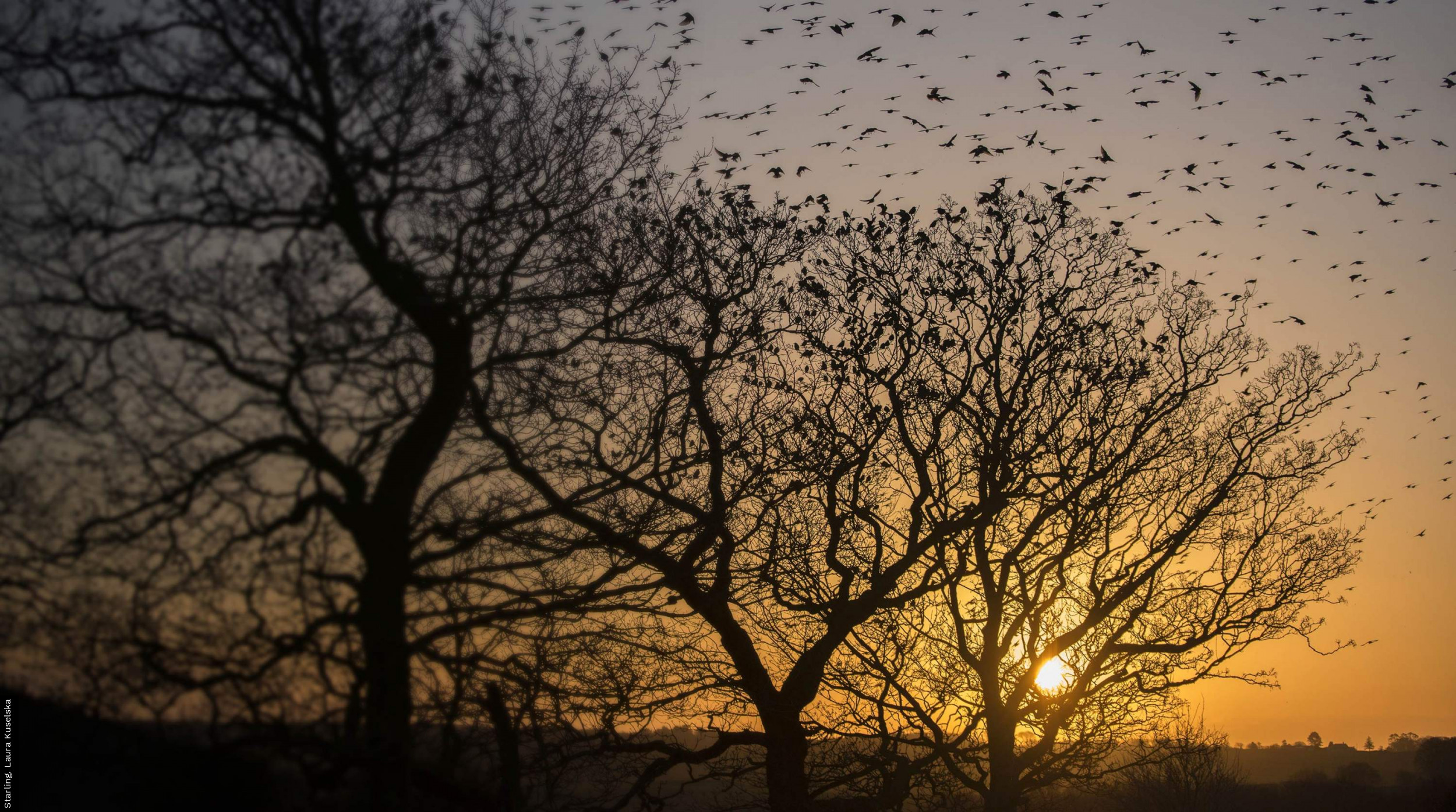Peer-reviewed papers

It is BTO’s policy to make public the results of our research. Our aim is to publish as much as possible of our work in the peer reviewed scientific literature. Many results are also published in our BTO Research Report series.
2022.
Linking climate change vulnerability research and evidence on conservation action effectiveness to safeguard European seabird populations.
Journal of Applied Ecology
Link to Article (DOI: 10.1111/1365-2664.14133)
2022.
A framework for climate change adaptation indicators for the natural environment.
Ecological Indicators
136
Link to Article (DOI: 10.1016/j.ecolind.2022.108690)
2022.
Warming temperatures drive at least half of the magnitude of long-term trait changes in European birds.
Proceedings of the National Academy of Sciences of the USA
119
Link to Article (DOI: 10.1073/pnas.2105416119)
2022.
Extreme uncertainty and unquantifiable bias do not inform population sizes.
Proceedings of the National Academy of Sciences of the USA
119
Link to Article (DOI: 10.1073/pnas.2113862119)
2022.
Impacts of COVID-19 restrictions on capacity to monitor bird populations: a case study using the UK Breeding Bird Survey.
Bird Study
Link to Article (DOI: 10.1080/00063657.2021.2019187)
2022.
An assessment of relative habitat use as a metric for species’ habitat association and degree of specialization.
Ecological Indicators
135
Link to Article (DOI: 10.1016/j.ecolind.2021.108521)
2022.
Large-scale citizen science survey of a common nocturnal raptor: urbanization and weather conditions influence the occupancy and detectability of the Tawny Owl Strix aluco.
Bird Study
View Abstract
Link to Article (DOI: /10.1080/00063657.2021.2019188)
2022.
The future distribution of wetland birds breeding in Europe validated against observed changes in distribution.
Environmental Research Letters
Link to Article (DOI: 10.1088/1748-9326/ac4ebe)
2022.
<p>Long-term effects of rewilding on species composition: 22 years of raptor monitoring in the Chernobyl Exclusion Zone</p>.
Restoration Ecology
Link to Article (DOI: 10.1111/rec.13633)
2022.
Drivers of change in mountain and upland bird populations in Europe.
Ibis
164 (part 3)
: 635-648
Link to Article (DOI: /10.1111/ibi.13043)
2022.
Multi-taxa spatial conservation planning reveals similar priorities between taxa and improved protected area representation with climate change.
Biodiversity and Conservation
Link to Article (DOI: 10.1007/s10531-022-02357-1)
2022.
Resilient protected area network enables species adaptation that mitigates the impact of a crash in food supply.
Marine Ecology Progress Series
681
: 211-225
Link to Article (DOI: 10.3354/meps13922)
2021.
Development of a weak-link wing harness for use on large gulls (Laridae): methodology, evaluation and recommendations.
Seabird
33
: 18-34
View Abstract
2021.
Pinpointing which protected area characteristics help community response to climate warming: waterbirds in the European Union’s Natura 2000 network.
Conservation Biology
Link to Article (DOI: 10.1111/cobi.13877)
2021.
The Icelandic Whooper Swan Cygnus cygnus population: current status and long-term (1986–2020) trends in its numbers and distribution.
Wildfowl Journal
71
: 29-57
View Abstract
2021.
Spatial and temporal differences in migration strategies among endangered European Greater Spotted Eagles Clanga clanga.
Bird Conservation International
Link to Article (DOI: 10.1017/S0959270921000411)
2021.
GPS tracking reveals landfill closures induce higher foraging effort and habitat switching in gulls.
Movement Ecology
Link to Article (DOI: 10.1186/s40462-021-00278-2)
2021.
Setting priorities for climate change adaptation of Critical Sites in the Africa-Eurasian waterbird flyways.
Global Change Biology
Link to Article (DOI: 10.1111/gcb.15961)
2021.
Better utilisation and transparency of bird data collected by powerline companies.
Journal of Environmental Management
302
Link to Article (DOI: 10.1016/j.jenvman.2021.114063)
2021.
Bird population declines and species turnover are changing the acoustic properties of spring soundscapes.
Nature Communications
View Abstract
Link to Article (DOI: 10.1038/s41467-021-26488-1)
2021.
Woodland management and birds. Part 2. Conservation measures and strategies.
Quarterly Journal of Forestry
115 (part 4)
: 238-244
2021.
Long term changes in the abundance of benthic foraging birds in a restored wetland.
Frontiers in Ecology and Evolution
Link to Article (DOI: 10.3389/fevo.2021.673148)
2021.
Rapid adaptive modelling for policy support towards achieving Sustainable Development Goals: Brexit and the livestock sector in Wales.
Environmental Science & Policy
125
Elsevier
: 21-31
Link to Article (DOI: 10.1016/j.envsci.2021.08.009)
2021.
Upward elevational shift by breeding Whinchat Saxicola rubetra in response to cessation of grazing in upland grassland.
Bird Study
View Abstract
Link to Article (DOI: 10.1080/00063657.2021.1963210)
2021.
Foraging habitat selection by breeding Herring Gull (Larus argentatus) from a declining coastal colony in the United Kingdom.
Estuarine, Coastal and Shelf Science
261
Link to Article (DOI: 10.1016/j.ecss.2021.107564)
2021.
Identifying and Mapping Groups of Protected Area Visitors by Environmental Awareness.
Land
10
Link to Article (DOI: 10.3390/land10060560)
2021.
Numbers of Spoon-billed Sandpipers in Jiangsu Province, China, during the post-breeding moult in relation to recent changes in the intertidal zone..
Wader Study
128 (part 2)
: 125-136
View Abstract
Link to Article (DOI: 10.18194/ws.00233)
2021.
The Shetland Bird Survey: Population trends for widespead breeding birds 2002-2019.
Bird Study/Ringing & Migration
View Abstract
Link to Article (DOI: 10.1080/00063657.2021.1955823)
2021.
Woodland management and birds. Part 1. Sylvicultural systems and tree species..
Quarterly Journal of Forestry
115
: 168-174
2021.
Sensitivities to land use change by breeding Short-eared Owl (Asio flammeus) in Britain.
Airo
29
: 54-65
View Abstract
2021.
Engaging schools with long-term monitoring of nature.
School Science Review
102
The Association for Science Education
: 27-31
View Abstract
2021.
Diversity of response and effect traits provides complementary information about avian community dynamics linked to ecological function.
Functional Ecology
35 (part 9)
: 1 938-1 950
Link to Article (DOI: 10.1111/1365-2435.13865)
2021.
When speed matters: The importance of flight speed in an avian collision risk model.
Environmental Impact Assessment Review
90
Elsevier
Link to Article (DOI: 10.1016/j.eiar.2021.106622)
2021.
Recovering the Eurasian Curlew in the UK and Ireland: progress since 2015 and looking ahead.
British Birds
114
: 341-350
2021.
Temperature and density influence survival in a rapidly declining migratory shorebird.
Biological Conservation
Link to Article (DOI: 10.1016/j.biocon.2021.109198)
2021.
Dynamic space use of Andalusian rice fields by Lesser Black-Backed Gulls (Larus fuscus) is driven by flooding.
Ibis
Link to Article (DOI: 10.1111/ibi.12968)
2021.
Nocturnal flight calling behaviour of thrushes in relation to artificial light at night.
Ibis
Link to Article (DOI: 10.1111/ibi.12955)
2021.
Evaluating the potential effects of capturing and handling on subsequent observations of a migratory passerine through individual acoustic monitoring.
Journal of Avian Biology
Link to Article (DOI: 10.1111/jav.02739)
2021.
Climate change exposure of waterbird species in the African-Eurasian flyways.
Bird Conservation International
Link to Article (DOI: 10.1017/S0959270921000150)
2021.
Human activity shapes the wintering ecology of a migratory bird.
Global Change Biology
Link to Article (DOI: 10.1111/gcb.15597)
2021.
Predator management for breeding waders: a review of current evidence and priority knowledge gaps.
Wader Study
2021.
Long-term and large-scale multispecies dataset tracking population changes of common European breeding birds.
Scientific Data
Link to Article (DOI: 10.1038/s41597-021-00804-2)
2021.
Migratory movements of British and Irish Common Shelduck Tadorna tadorna: a review of ringing data and a pilot tracking study to inform potential interactions with offshore wind farms in the North Sea.
Ringing & Migration
Link to Article (DOI: 10.1080/03078698.2019.1887670)
2021.
Interventions can shift the thermal optimum for parasitic disease transmission.
Proceedings of the National Academy of the United States of America
118
Link to Article (DOI: 10.1073/pnas.2017537118)
2021.
Climate and land use changes: similarity in range and abundance changes of birds in Finland and Great Britain.
Ornis Fennica
View Abstract
2021.
Wader populations on the UK’s open coast: results of the 2015/16 Non-Estuarine Waterbird Survey (NEWS-III) and a review of population trends.
Bird Study
67
: 371-384
Link to Article (DOI: 10.1080/00063657.2021.1884184)
2021.
Covariation in population trends and demography reveals targets for conservation action.
Proceedings of the Royal Society B
Link to Article (DOI: 10.1098/rspb.2020.2955)
2021.
Populations of high‐value predators reflect the traits of their prey.
Ecography
44
: 1-13
View Abstract
Link to Article (DOI: 10.1111/ecog.05438)
2021.
A comparison of breeding bird populations inside and outside of European Badger Meles meles control areas.
Bird Study
Link to Article (DOI: 10.1080/00063657.2021.1889460)
2021.
Effect of a joint policy statement by nine UK shooting and rural organisations on the use of lead shotgun ammunition for hunting common pheasants Phasianus colchicus in Britain.
Conservation Evidence
18
: 1-9
View Abstract



Share this page